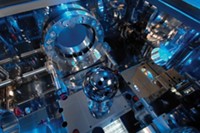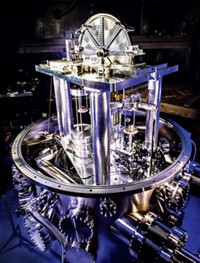Advertisement
Grab your lab coat. Let's get started
Welcome!
Welcome!
Create an account below to get 6 C&EN articles per month, receive newsletters and more - all free.
It seems this is your first time logging in online. Please enter the following information to continue.
As an ACS member you automatically get access to this site. All we need is few more details to create your reading experience.
Not you? Sign in with a different account.
Not you? Sign in with a different account.
ERROR 1
ERROR 1
ERROR 2
ERROR 2
ERROR 2
ERROR 2
ERROR 2
Password and Confirm password must match.
If you have an ACS member number, please enter it here so we can link this account to your membership. (optional)
ERROR 2
ACS values your privacy. By submitting your information, you are gaining access to C&EN and subscribing to our weekly newsletter. We use the information you provide to make your reading experience better, and we will never sell your data to third party members.
Environment
Redefining The Kilogram And Mole
by Peter F. Rusch, Chair, Committee On Nomenclature, Terminology & Symbols
May 30, 2011
| A version of this story appeared in
Volume 89, Issue 22

Because of the possible mass change of the international prototype kilogram—the last of the International System of Units (SI) base units still defined by a physical artifact—the metrology community proposed a redefinition of the kilogram. This proposal led to a recommendation to redefine other SI base units, including the kelvin, ampere, and mole. Definitions of the second, meter (or metre), and candela will remain unchanged, although they will be worded differently. The new “fixed constant” definitions will rely on values of physical constants recognized as invariants of nature.
Definitions of SI base units are approved by the General Conference on Weights & Measures (CGPM), a treaty organization founded in 1875 by the Metre Convention, of which the U.S. is a member state. CGPM convenes every four years and is scheduled to meet this October.
Prior to going to CGPM, work is done by bureaus and committees in preparation for the conference. For chemists, the International Committee for Weights & Measures (CIPM) is a primary focus as its stated principal task is to promote worldwide uniformity in units of measurement, either through direct action or by submitting draft resolutions to CGPM.
CIPM works through consultative committees, one of which is the Consultative Committee for Units (CCU). Recent deliberations of CCU have lacked strong engagement on the part of the U.S. chemistry community, so the American Chemical Society’s Committee on Nomenclature, Terminology & Symbols has undertaken the task of determining what is being proposed and what it means to chemistry.
The work of CCU is now mostly complete, and a draft resolution for CIPM to present to CGPM is now available with the following definitions:
“The kilogram, kg, is the unit of mass; its magnitude is set by fixing the numerical value of the Planck constant to be equal to exactly 6.626068 … × 10-34 when it is expressed in the unit s-1 m2 kg which is equal to J s.
“The mole, mol, is the unit of amount of substance of a specified elementary entity, which may be an atom, molecule, ion, electron, any other particle or a specified group of such particles; its magnitude is set by fixing the numerical value of the Avogadro constant to be equal to exactly 6.022141 … × 1023 when it is expressed in the unit mol-1.”
The ellipses in the definitions are intentional at this time as the final resolution awaits the most recent, accurate values of the constants to be used when the final resolution is presented to CGPM.
The definitions themselves do not explain how each constant is related to the unit it defines. This is intentional because CCU believes that the method of “realizing the definition”—that is, connecting the constant to the unit—should not be specified. Development of new methods for doing so may come at any time and may be quite different from what is used today. Still, the definition would remain valid because it is independent of the method.
The proposed definition of the kilogram offers some challenges because it is not obvious how Planck’s constant is related to the kilogram. Making that relationship today requires the use of a watt balance, an elaborate electromagnetic device for determining mass using a combination of constants including the noninvariant gravitational constant. Only a few of these complex, expensive instruments exist today. In practice, chemists rely on secondary standards for mass, and that won’t change. Accordingly, it matters little to chemists what instrument is used to calibrate the secondary standards, so long as their mass is accurate.
The definition of the mole is more problematic. Currently, the definition is connected directly to the mass of a carbon-12 isotope and the kilogram. According to the current definition, the mass of carbon-12 is an absolute invariant of nature. In the proposed definition, the value of Avogadro’s constant is the fixed invariant of nature, leaving the mass of carbon-12 to be determined experimentally. Using metrological methods and the best accepted values of other constants, it is calculated that the mass of carbon-12 will have an uncertainty of 1.4 × 10-9 u (u is the unified atomic mass unit). Since all atomic weights are currently defined on carbon-12 as 12 u exactly, all atomic weights will change by small amounts.
For many chemical practices, this is an insignificant difference from the current 12 u exactly. In fact, average atomic weights often change as isotopic distributions become better known.
For chemical practice at the atomic level, however, this difference can be considerable. In particular, the mass spectrometry community is concerned about the loss of the carbon-12 standard of 12 u exactly. Currently assessed in parts-per-billion charge-to-mass ratios, MS results will be subject to recalculation each time the carbon-12 mass is more precisely determined.
Proposed definitions of the SI base units will wait until the 2015 CGPM for possible adoption. In the meantime, all of the constituents of the chemical enterprise have the time and the opportunity to review the proposals and evaluate their impact on the practice of chemistry.
Views expressed on this page are those of the author and not necessarily those of ACS.







Join the conversation
Contact the reporter
Submit a Letter to the Editor for publication
Engage with us on Twitter